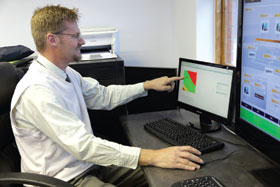

International consulting engineering firm and water treatment specialists Royal HaskoningDHV has achieved a first in Africa with the installation of an Expert System from the firm’s Aquasuite basket of water and waste water treatment products at the new Fisantekraal wastewater treatment works (WWTW) outside Cape Town.
The revolutionary Nereda wastewater treatment process implemented at the much publicised and award winning Gansbaai WWTW is already utilising a well known Aquasuite solution (i.e. the Nereda Controller) and another similar installation is in progress at a second Nereda WWTW at Wemmershoek near Franshoek.
Building on these successes, a decision support system (DSS) has been installed at the new Fisantekraal WWTW where it is being used to optimise the control of the biological reactors for nutrient removal in a conventional UCT process to treat waste water. The DSS consists of propriety software running on a separate computer installed in the WWTW control room alongside the plant scada. It is linked to the bioreactor PLCs as well as on-line analytical instrumentation via the plant wide fibre optic network in order to retrieve data from the process and provide decision support to the plant operator.
Essentially the DSS is an ‘Expert System’ that runs a computational model of the biological reactor and various biological and chemical processes. By way of statistical analysis and models its predictions provide the human operator with information and guidance as to the optimal control settings for the reactor. Although possible, the DSS is currently only acting in a guiding role and not yet directly influencing the control loops in the reactors.
The Fisantekraal WWTW makes use of a modified University of Cape Town Process (MUCT) and incorporates the technology of the 3-Stage Phoredox Process. This process is capable of both nitrogen and phosphorus removal. Furthermore, a facility for dosing ferric chloride has also been provided for assistance with phosphate removal if and when required. Traditionally, regular manual laboratory analysis informs the operator as to the state of his process and minor adjustments are made to flow and aeration control in order to achieve optimal operation and affect ferric dosing when needed. This process does not necessarily take daily flows and temperature variations into consideration and it is therefore possible for the reactor to operate ‘out of spec’ from time to time before corrections can be made. In order to improve on this task, a DSS uses advanced on-line analytical instrumentation to provide on-line analysis and since the plant was designed with a Fieldbus system and the basic flow and dissolved oxygen metering in place, the addition of on-line ammonia, nitrate, phosphate, pH and redox analysers was a relatively simple task. The electrical power consumption of the bioreactor surface aerators is also taken into account in the predictive model and decision support.
The DSS therefore operates on a dashboard basis assisting in the analysis of online data in making control and policy decisions. The KPIs are presented in an online local as well as Web based environments, which can be accessed by operators and remote supporting staff alike. Operators are able to assess the operational state of the plant at a glance. Vast amounts of data are summarised and presented in real-time and different WWTWs of the same municipality can easily be compared in a uniform environment via the Web interface.
The complete system is also monitored remotely by the suppliers from the Netherlands via a secure Internet connection. The purchase agreement includes one year’s remote support and optimisation of the model.
For more information contact Hillary Erasmus, Royal HaskoningDHV, +27 (0)11 798 6511, [email protected], www.rhdhv.co.za

© Technews Publishing (Pty) Ltd | All Rights Reserved